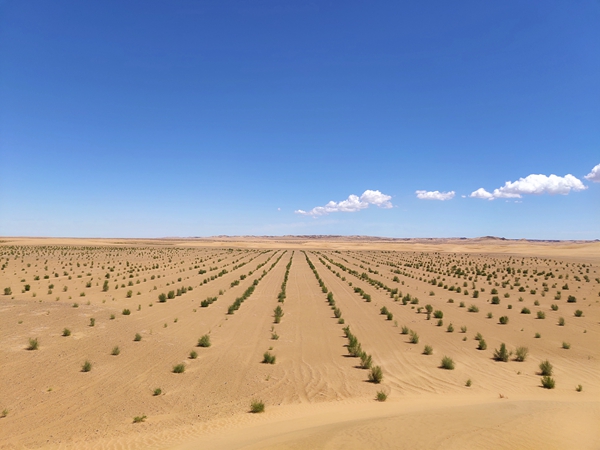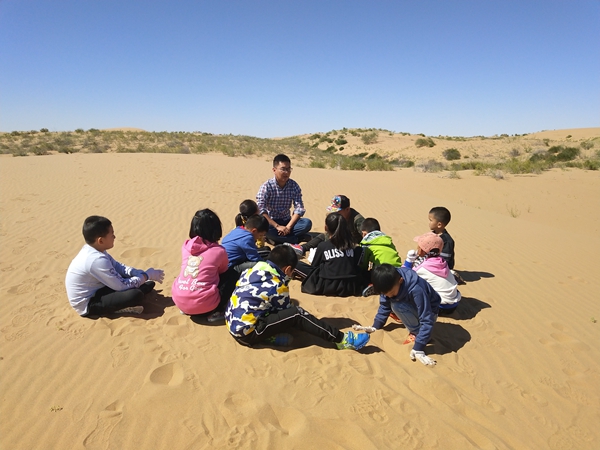
One day in 2012, Zhu had dinner at a friend's home after work. The main meal was stewed mutton. Zhu asked his friend about the recipe and his friend showed Zhu a plant-it was the mysterious flora he had seen a year ago. Zhu learned that the plant was a saxaul tree.
Saxaul trees, or Haloxylon ammodendron, an ultraxerophytic small tree of the Chenopodiaceae family, are an excellent tree species for sand fixation and afforestation in desert areas. It's commonly seen, though easily ignored. It is widely distributed in Chinese desert regions, such as Inner Mongolia, the Ningxia Hui autonomous region and Gansu province.
Known as a desert guardian, a fully grown saxaul tree can hold together a 10-square-meter patch of desert land, according to Zhu.
"I didn't expect that the small plant would change my life," says Zhu, 35, who quit his job at the design institute in 2014 and joined a nonprofit organization, the Society of Entrepreneurs and Ecology Conservation, or SEE, in the same year, concentrating on tackling desertification.
The organization, dedicated to ecological protection and social responsibility, was initiated by about 100 entrepreneurs on June 5, 2004, in Tengger Desert, located in the Alshaa League of Inner Mongolia.

During the past eight years, Zhu has been leading a team from SEE to plant saxaul trees in sandy areas in Alshaa League and other places of Inner Mongolia.
On Sept 2, during an online charity concert streamed on platforms of the Tencent Music Entertainment Group, Zhu shared his stories about saxaul trees along with other representatives from nonprofit organizations involved in environmental and wild animal protection.
Zhu was born in Bayanhot town, Alshaa Left Banner, which is about 700 km from Hohhot, capital of Inner Mongolia.
"I love my hometown. However, I didn't like spring, though it's supposed to be a season for new life and vibrancy," says Zhu. "I can only remember the wind during spring being strong and endless. During the days with very strong wind, my mother usually locked me at home because strong winds usually meant a sandstorm was coming, which is very dangerous."
Zhu recalls two sandstorms in particular, one when he was a primary school student and the other when he had just graduated from college. Both caused an electricity blackout. Thick sand blanketed Zhu's house and the streets. Domestic animals, unless they were kept indoors, were swept away.
"As a child, I wondered if the strong winds and sandstorms would ever disappear. I always wanted to do something for my hometown," says Zhu.
Zhu usually drives hours across the desert areas of Inner Mongolia with his team members to do research, plant saxaul trees and check those planted previously. They would usually stay in the desert for several days. Their skin, red in patches, bears testimony to the conditions they endure.
"It usually takes four or five years for a saxaul tree to become fully grown. When the tree is around the same height as me, I feel rewarded and excited. It's a great pleasure to me," says Zhu.
In 2014, the SEE launched a project titled "one million saxaul trees", aiming to plant that number from 2014 to 2023, turning the desert of more than 133,330 hectares back into a thriving ecosystem. By the end of 2018, half of the organization's goal had been achieved.
In 2016, Ant Finance, an affiliate of Alipay, cooperated with SEE to introduce the Ant Forest platform, not only encouraging people to choose "a low-carbon way" of shopping, traveling and living, but also to help control desertification.
Through the participation of a greater number of online users, who grow virtual trees, the SEE Foundation, set up in 2008, has been providing subsidies for local herdsmen and farmers while also offering technological support to plant saxaul trees in desert areas.
According to the foundation, in 2021, more than 9.5 million saxaul trees have been planted in Alshaa League, covering about 14,670 hectares. This year, saxaul trees covering 4,333 hectares have already been planted.
Now, Zhu is the head of the foundation's project to combat desertification. He also gives lectures about saxaul trees and the fight against desertification at schools of Alshaa League and other regions of Inner Mongolia, hoping to raise awareness among young people.














